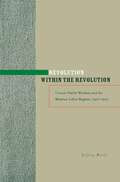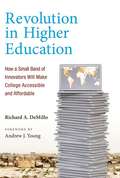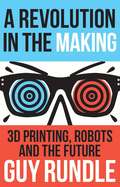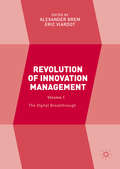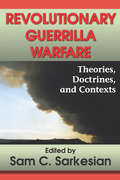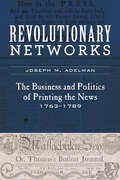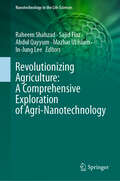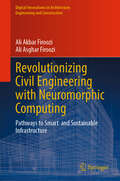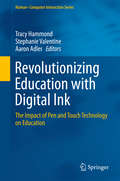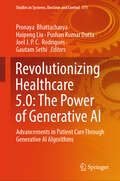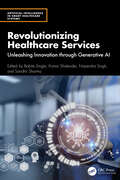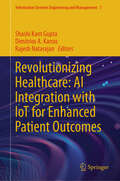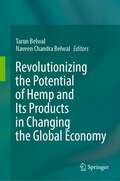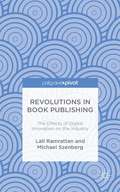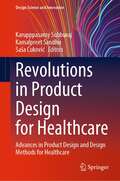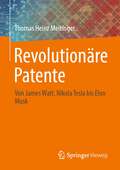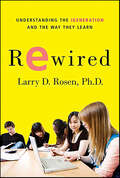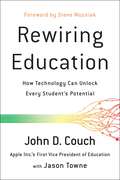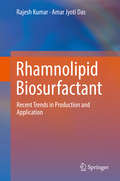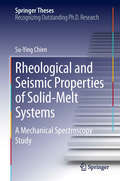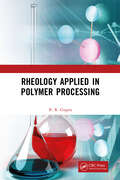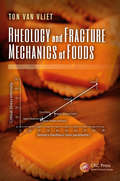- Table View
- List View
Revolution Within the Revolution
by Jeffrey BortzMexico's revolution of 1910 ushered in a revolutionary era: during the twentieth century, Mexican, Russian, Chinese, Cuban, Nicaraguan, and Iranian revolutions shaped local, regional, and world history. Because Mexico was at the time a rural and agrarian country, it is not surprising that historians have concentrated on the revolution in the countryside where the rural underclass fought for land. This book uncovers a previously unknown workers' revolution within the broader revolution. Working in Mexico's largest factory industry, cotton textile operatives fought their own fight, one that challenged and overthrew the old labor regime and changed the social relations of work. Their struggle created the most progressive labor regime in Latin America, including but not limited to the famous Article 123 of the 1917 Constitution. Revolution within the Revolution analyzes the rules of labor and explains how they became a pillar of the country's political system. Through the rest of the twentieth century, Mexico's land reform and revolutionary labor regime allowed it to avoid the revolution and repression experienced elsewhere in Latin America.
Revolution in Higher Education
by Richard A. DemilloColleges and universities have become increasingly costly, and, except for a handful of highly selective, elite institutions, unresponsive to twenty-first-century needs. But for the past few years, technology-fueled innovation has begun to transform higher education, introducing new ways to disseminate knowledge and better ways to learn -- all at lower cost. In this impassioned account, Richard DeMillo tells the behind-the-scenes story of these pioneering efforts and offers a roadmap for transforming higher education. Building on his earlier book, Abelard to Apple, DeMillo argues that the current system of higher education is clearly unsustainable. Colleges and universities are in financial crisis. Tuition rises inexorably. Graduates of reputable schools often fail to learn basic skills, and many cannot find suitable jobs. Meanwhile, student-loan default rates have soared while the elite Ivy and near-Ivy schools seem remote and irrelevant. Where are the revolutionaries who can save higher education? DeMillo's heroes are a small band of innovators who are bringing the revolution in technology to colleges and universities. DeMillo chronicles, among other things, the invention of MOOCs (Massive Open Online Courses) by professors at Stanford and MIT; Salman Khan's Khan Academy; the use of technology by struggling historically black colleges and universities to make learning more accessible; and the latest research on learning and the brain. He describes the revolution's goals and the entrenched hierarchical system it aims to overthrow; and he reframes the nature of the contract between society and its universities. The new institutions of a transformed higher education promise to demonstrate not only that education has value but also that it has values -- virtues for the common good.
Revolution in the Making
by Guy RundleJust as you were getting comfortable with a digital world, here comes the material revolution, a transformation in the production and distribution of, well, everything. 3D printing has broken out of its limited industrial uses and landed on a million desktops. New materials, such as graphene, will make it possible to print out complex and durable machines at costs approaching zero. Guy Rundle talks to the people at the frontline of this mind-boggling new world, and paints a vivid picture of how life will change as today's emerging technologies become mainstream. There will be enormous implications not just for Australia, but for the global economy, international relations and the fundamental structures of our lives.
Revolution of Innovation Management
by Eric Viardot Alexander BremThis edited collection explores how digitalization is changing the management of innovation, and the subsequent implications for the next phases in its development. The authors identify and examine relevant phenomena which are related to the ongoing digital breakthrough in the context of innovation management such as user innovation, crowd sourcing and crowd funding, as well as social media. In line with the constant globalization of innovation, the first volume of Revolution of Innovation Management offers a variety of international perspectives on these topics with illustrations and analysis coming from Asia, America, and Europe.
Revolution of Perovskite: Synthesis, Properties and Applications (Materials Horizons: From Nature to Nanomaterials)
by Narayanasamy Sabari Arul Vellalapalayam Devaraj NithyaThis volume presents advanced synthesis techniques for fabricating Perovskite materials with enhanced properties for applications such as energy storage devices, photovoltaics, electrocatalysis, electronic devices, photocatalysts, sensing, and biomedical instruments. The book attempts to fill a gap in the published literature and provide a detailed reference on Perovskite materials. This book will be of use to graduate students and academic and industrial researchers in the fields of solid-state chemistry, physics, materials science, and chemical engineering.
Revolutionary Guerrilla Warfare: Theories, Doctrines, and Contexts
by Sam C. Sarkesian'Revolution' is a word that causes fear in some, exhilaration in others, and confusion in most. Originally used to describe a restoration, it eventually came to mean a sweeping, sudden attack on an existing order. Human history has borne witness to a variety of national and social revolutions - population revolution, revolution of ideas, technological revolution, and revolution in education. Simultaneously, there has been a proliferation of literature on revolution, armed struggle, and violence aimed at unseating policies and leadership of governments and societies.Revolutionary struggles are more than simply armed internal conflict; they involve the essence of the political system. The desire to make such phenomena understandable often leads to oversimplification. Attempts to encompass their multi-dimensional nature, on the other hand, can become immersed in complexities, ambiguities, and misinterpretations. The perspective of this classic volume, available in paperback for the first time, is that revolution is here to stay. Guerrilla warfare, according to Sarkesian, is a particularly useful strategy for the weak, the frustrated, the alienated, and seekers of power against existing regimes. The collected works in this volume examine the social roots of revolution, development of strategy and tactics, practice in city and countryside, dilemmas of attackers and defenders.The actors and thinkers collected and analyzed here range from leading political analysts, anthropologists, sociologists, historians, and officials as well as practitioners of guerrilla warfare. This core text with primary sources in the area of war, revolution, and insurgence develops an understanding of revolution, traces the growth of guerilla doctrine, and studies the specifics of revolutionary and counterrevolutionary guerilla warfare.
Revolutionary Networks: The Business and Politics of Printing the News, 1763–1789 (Studies in Early American Economy and Society from the Library Company of Philadelphia)
by Joseph M. AdelmanAn engrossing and powerful story about the influence of printers, who used their commercial and political connections to directly shape Revolutionary political ideology and mass mobilization.Honorable Mention, St. Louis Mercantile Library Prize, Bibliographical Society of AmericaDuring the American Revolution, printed material, including newspapers, pamphlets, almanacs, and broadsides, played a crucial role as a forum for public debate. In Revolutionary Networks, Joseph M. Adelman argues that printers—artisans who mingled with the elite but labored in a manual trade—used their commercial and political connections to directly shape Revolutionary political ideology and mass mobilization. Going into the printing offices of colonial America to explore how these documents were produced, Adelman shows how printers balanced their own political beliefs and interests alongside the commercial interests of their businesses, the customs of the printing trade, and the prevailing mood of their communities. Adelman describes how these laborers repackaged oral and manuscript compositions into printed works through which political news and opinion circulated. Drawing on a database of 756 printers active during the Revolutionary era, along with a rich collection of archival and printed sources, Adelman surveys printers' editorial strategies. Moving chronologically through the era of the American Revolution and to the war's aftermath, he details the development of the networks of printers and explains how they contributed to the process of creating first a revolution and then the new nation.By underscoring the important and intertwined roles of commercial and political interests in the development of Revolutionary rhetoric, this book essentially reframes our understanding of the American Revolution. Printers, Adelman argues, played a major role as mediators who determined what rhetoric to amplify and where to circulate it. Offering a unique perspective on the American Revolution and early American print culture, Revolutionary Networks reveals how these men and women managed political upheaval through a commercial lens.
Revolutionizing Agriculture: A Comprehensive Exploration of Agri-Nanotechnology (Nanotechnology in the Life Sciences)
by Abdul Qayyum Sajid Fiaz Raheem Shahzad Mazhar Ul Islam In-Jung LeeAgriculture is facing unprecedented challenges including climate change, declining arable land, and a growing global population. To meet the increasing demand for food while minimizing environmental impact, innovative solutions are required. Nanotechnology offers promising avenues to enhance agricultural productivity, sustainability, and food security. "Revolutionizing Agriculture: A Comprehensive Exploration of Agri-Nanotechnology" is an ambitious and timely book that sheds light on the transformative potential of nanotechnology in agriculture. This book is an exploration of agri-nanotechnology covering foundational principles, various applications, environmental considerations, and future trends. It serves as a valuable resource for researchers, academics, students, policymakers, and industry professionals interested in the intersection of nanotechnology and agriculture. By addressing both the scientific and societal implications of agri-nanotechnology, this book contributes to the sustainable development of agriculture in the 21st century. This book... Expands existing knowledge and understanding of applications of nano-materials in agriculture, exploring their chemical structures, properties, and biological activities; Provides readers with a foundational understanding of nanoscale science and its relevance to agriculture; Explores various types of nanomaterials and their applications in crop production, soil management, and pest control; Discusses the use of nanosensors for real-time monitoring of soil and crop conditions, as well as data analytics for precision agriculture; Addresses the development of nanopesticides, nanofertilizers, and nanodelivery systems to reduce chemical use and enhance crop protection; Examines how nanotechnology can contribute to sustainable practices such as water management, waste reduction, and energy efficiency; Discusses the regulatory framework and ethical concerns surrounding the use of nanotechnology in agriculture; Bridges the gap between the fields of agriculture, biotechnology, chemical and physical sciences.
Revolutionizing Aircraft Materials and Processes
by Konstantinos Tserpes Spiros PantelakisThis book addresses the emerging needs of the aerospace industry by discussing recent developments and future trends of aeronautic materials. It is aimed at advancing existing materials and fostering the ability to develop novel materials with less weight, increased mechanical properties, more functionality, diverse manufacturing methods, and recyclability. The development of novel materials and multifunctional materials has helped to increase efficiency and safety, reduce costs, and decrease the environmental foot print of the aeronautical industry. In this book, integral metallic structures designed by disruptive concepts, including topology optimization and additive manufacturing, are highlighted.
Revolutionizing Civil Engineering with Neuromorphic Computing: Pathways to Smart and Sustainable Infrastructure (Digital Innovations in Architecture, Engineering and Construction)
by Ali Akbar Firoozi Ali Asghar FirooziThis book delves into the transformative potential of neuromorphic computing within the realm of civil engineering, emphasizing its role in advancing smart infrastructure systems. Neuromorphic computing, inspired by the neural structures of the human brain, offers unparalleled efficiencies in processing complex, dynamic data sets, thereby facilitating real time decision-making and predictive analytics in infrastructure management. Through a comprehensive exploration of emerging circuits, memory technologies, intelligent learning algorithms, and application-driven systems, it illustrates how neuromorphic computing can significantly enhance the resilience, efficiency, and sustainability of urban infrastructure. The book further addresses the challenges, ethical considerations, and future directions associated with the integration of these advanced technologies into civil engineering projects. Through detailed case studies, it provides insights into successful implementation strategies, risk management, and contingency planning, underscoring the importance of ethical design and development. This book serves as a valuable resource for practitioners, researchers, and policymakers involved in the evolution of civil engineering toward smarter, more responsive, and sustainable urban environments.
Revolutionizing Education with Digital Ink
by Aaron Adler Tracy Hammond Stephanie ValentineDerived from contributions to the Workshop on Pen and TouchTechnology on Education (WIPTTE) in 2015, this edited volume highlights recentdevelopments for pen and tablet research within the education system with aparticular focus on hardware and software developments, comprising theperspectives of teachers, school and university administrators, and researchersfor educators at every level. Split into six distinct parts, the book explores topics like howclassrooms are increasingly using sketch-based videos, created by teachers andstudents alike, and how the teaching of key skills such as literacy, languages,math, and art via pen and touch technologies within the classroom are leadingto improvements in engagement, learning, and retention levels amongst students. Future perspectives of digital learning, as envisioned by current high schoolstudents, are also explored. Revolutionizing Education with Digital Inkis a must-read for those seeking to understand the direction of current andfuture pen and touch research, its current use in classrooms, and futureresearch directions.
Revolutionizing Healthcare 5.0: Advancements in Patient Care Through Generative AI Algorithms (Studies in Systems, Decision and Control #571)
by Joel J. P. C. Rodrigues Pronaya Bhattacharya Pushan Kumar Dutta Gautam Sethi Haipeng LiuThis book serves as a critical resource that bridges the gap between burgeoning technology and its practical implementation. The book starts with an in-depth exploration of healthcare 5.0 principles, laying the foundation for the reader to understand the current shifts in healthcare paradigms. Then, it dives into the intricacies of generative models in healthcare, detailing how these algorithms work and the applications they serve. The book further delves into the subsets of generative machine learning and deep learning techniques in healthcare. As we move towards more complex applications, the book takes a turn to address the critical subject of interpretability and explainability in generative models, a topic that resonates profoundly given the life-critical nature of medical decisions. Finally, the book concludes with a robust discussion on the security and privacy concerns that accompany the deployment of GAI in real healthcare settings. By offering a multidimensional viewpoint—coupled with case studies, statistical analyses, and expert insights—the book ensures that the reader is left with a nuanced understanding of how GAI can be both a boon and a challenge in healthcare. As such, the proposed book serves as an indispensable resource for healthcare professionals, data scientists, researchers, and anyone invested in the future of healthcare and AI.
Revolutionizing Healthcare Services: Unleashing Innovation through Generative AI (Artificial Intelligence in Smart Healthcare Systems)
by Nripendra Singh Babita Singla Kumar Shalender Sandhir SharmaThe increasing prominence of generative AI across various industries presents an abundance of opportunities for integration within the healthcare sector. From generating valuable insights about patients to automating operations, streamlining patient care, and implementing preventive technologies, the use of generative AI has the potential to usher in a new era of productivity and profitability for stakeholders within the healthcare ecosystem.Revolutionizing Healthcare Services: Unleashing Innovation through Generative AI explores the current and potential applications of generative AI in the healthcare sector. It covers regulatory frameworks, ethical considerations, practical applications, and real-world use cases. The book also provides a forward-looking perspective to help the healthcare industry keep pace with the integration of generative AI and its applications. In addition, it looks at the future potential of generative AI in conjunction with blockchain, machine learning, and predictive modeling to create electronic health records that can be shared across the healthcare ecosystem. By examining the detailed insights on how to integrate generative AI models with existing healthcare systems, the potential to enhance patient care services can be brought to the forefront. Practical strategies are also discussed to seamlessly integrate generative AI into healthcare services, ensuring prompt, reliable, and efficient care while prioritizing urgent needs.This book aims to equip healthcare professionals with the knowledge and tools needed to leverage generative AI for superior patient care delivery. It is designed to appeal to a wide range of audiences, including healthcare professionals, generative AI developers, data scientists, healthcare practitioners, patients, educators, policymakers, and those with the knowledge and tools needed to leverage generative AI for superior patient care delivery. The coverage, diverse perspective, and practical approach make it suitable for both beginners looking for an introduction to generative AI and experienced experts.
Revolutionizing Healthcare: AI Integration with IoT for Enhanced Patient Outcomes (Information Systems Engineering and Management #7)
by Shashi Kant Gupta Dimitrios A. Karras Rajesh NatarajanThis book showcases an endeavor to delve into the fusion of artificial intelligence (AI) and the Internet of Things (IoT) within the healthcare domain. The healthcare sector is currently experiencing a shift fueled by technological advancements and a heightened focus on providing tailored, efficient and impactful care to individuals. AI and IoT have emerged as facilitators of this evolution presenting opportunities to elevate patient results streamline operations and enhance decision-making within healthcare environments. This publication unites an array of viewpoints from experts in healthcare, technology and research domains. Through an array of enlightening chapters readers will embark on a journey exploring the applications, hurdles and consequences of merging AI with IoT in healthcare contexts. From analytics and remote monitoring to treatment suggestions and operational enhancements the potentials offered by AI and IoT is both captivating and revolutionary. As editors overseeing this volume’s creation we take pride in presenting an assemblage of contributions that mirror the research findings, innovations and optimal practices in healthcare technology. Our aim is to encourage readers to engage in thinking, creativity and teamwork when considering the impact of integrating AI with IoT on enhancing patient care and healthcare services.
Revolutionizing Healthcare: Impact of Artificial Intelligence on Diagnosis, Treatment, and Patient Care (Studies in Computational Intelligence #1182)
by Ajith Abraham Thipendra P. Singh Chandan Jyoti Kumar Kingsley Theophilus IguluThis book explores the transformative role of artificial intelligence (AI) in healthcare, emphasizing its shift from a futuristic concept to an essential part of modern medical systems. The articles cover a range of AI applications, from disease diagnosis and drug design to patient engagement and mental health treatment. Advances in machine learning (ML) and deep learning (DL) technologies have opened new possibilities for diagnosing complex conditions, with examples like predictive analysis for health risks and early diagnosis of diseases such as breast cancer and diabetic retinopathy. Additionally, AI's role in treating mental health disorders is highlighted. While AI offers vast benefits, the book stresses the importance of ethical considerations, such as patient privacy and equitable access. It also addresses challenges in integrating AI within existing healthcare systems, underscoring collaboration among stakeholders as crucial. This book ultimately provides a comprehensive look at AI’s potential to reshape healthcare.
Revolutionizing the Potential of Hemp and Its Products in Changing the Global Economy
by Tarun Belwal Naveen Chandra BelwalThis book provides the current status, research advances, challenges and opportunities of hemp products along with recommendations for future research. The surge in demand is fueling a global Green Rush, even in countries where a legal market for hemp products was unthinkable just a few years ago. The hemp market is growing globally and its products (fiber, food, medicine, etc.) are overwhelmingly accepted by the customers. With increasing market demand for more natural and greener products, the revolutionizing potential of hemp and its products in changing economy plays a major role. Moreover, considering their high demand and development of new varieties for producing raw material of need, breeding tools provide an effective means of development of varieties.This book aims to highlight the revolutionizing potential of hemp and its products in changing the economy, current status, and challenges. In addition, it provides the multi-functional and multi-industrial potential of hemp.
Revolutions in Book Publishing: The Effects Of Digital Innovation On The Industry
by Michael Szenberg Lall RamrattanRevolutions in Product Design for Healthcare: Advances in Product Design and Design Methods for Healthcare (Design Science and Innovation)
by Karupppasamy Subburaj Kamalpreet Sandhu Saša ĆukovićThis book coherently presents advances in design principles, processes, and methods in healthcare product design. It captures the implications of technological advances on designing healthcare products especially when market and societal needs pull each other in opposite directions. The contents focus on innovative design thinking processes and methods in developing healthcare products, applications of digital technologies in healthcare product design, amalgamation of artificial intelligence and design thinking for healthcare product design and quality, sustainability, and regulatory aspects in the design process. This book is a useful reference for those in the industry and academia.
Revolutionäre Patente: Von James Watt, Nikola Tesla bis Elon Musk
by Thomas Heinz MeitingerVergleicht man das Leben, das Denken und die Schriften der alten Römer oder Griechen mit dem heutigen Leben, wird man keine wesentlichen Unterschiede in der Klarheit der Gedanken oder der Eloquenz der Erzählweise feststellen können. Vergleicht man jedoch die Technologien der alten Römer mit den heute bekannten Technologien, erkennt man, dass auf dem technischen Gebiet gewaltige Fortschritte geschaffen wurden. Entscheidende technische Fortschritte sind immer mit berühmten Erfindern und Wissenschaftlern verbunden. Diese prägen ihre Zeit und das Leben der nachfolgenden Generationen. Auf wichtigen technischen Durchbrüchen werden oft industrielle Imperien errichtet.Dieses Buch zeigt die technischen Aufgaben, denen sich die Erfinder gegenüber sahen, ihre Erfindungen und was aus diesen Erfindungen entstand. Das Buch soll Faszination für Technik vermitteln und zur wirtschaftlichen Realisierung eigener Erfindungen ermuntern, die zumeist durch das Anmelden der Erfindung zum Patent beginnt.
Rewired: Understanding the iGeneration and the Way They Learn
by Larry Rosen“This book offers insight and help to motivate and maximize learning for the Internet Generation”—from the coauthor of The Distracted Mind (Eric Milou, Professor of Mathematics, Rowan University).Look around at today's youth and you can see how technology has changed their lives. They lie on their beds and study while texting and chatting online with friends and scrolling through TikTok. How does the new, charged-up, multitasking generation respond to traditional textbooks and lectures? Are we effectively reaching today's technologically advanced youth? Rewired is the first book to help educators and parents teach to this new generation's radically different learning styles and needs. This book will also help parents learn what to expect from their “techie” children concerning school, homework, and even socialization. In short, it is a book that exposes the impact of generational differences on learning while providing strategies for engaging students at school and at home.“Larry's research-based, positive, proactive messages are a welcome relief from the unsupported fear-based messages that are unfortunately also present. Rewired should be considered a ‘must-read' by all professionals who work with youth, especially those in leadership positions.” ―Nancy Willard Director of Center for Safe and Responsible Internet Use
Rewiring Education: How Technology Can Unlock Every Student's Potential
by John D. Couch Jason TowneWhat if we could unlock the potential in every child? As it turns out, we can. Apple's iconic cofounder Steve Jobs had a powerful vision for education: employing technology to make an enormous impact on the lives of millions of students. To realize this vision, Jobs tapped John D. Couch, a trusted engineer and executive with a passion for education. Couch believed the real purpose of education was to help children discover their unique potential and empower them to reach beyond their perceived limitations. Today, technology is increasingly integrated into every aspect of our lives, rewiring our homes, our jobs, and even our brains. Most important, it presents an opportunity to rewire education to enrich and strengthen our schools, children, and society In Rewiring Education, Couch shares the professional lessons he's learned during his 50-plus years in education and technology. He takes us behind Apple's major research study, Apple Classrooms of Tomorrow (ACOT), and its follow-up (ACOT 2), highlighting the powerful effects of the Challenge-Based Learning framework. Going beyond Apple's walls, he also introduces us to some of the most extraordinary parents, educators, and entrepreneurs from around the world who have ignored the failed promises of memorization and, instead, utilize new science-backed methods and technologies that benefit all children, from those who struggle to honor students. Rewiring Education presents a bold vision for the future of education, looking at promising emerging technologies and how we—as parents, teachers, and voters—can ensure children are provided with opportunities and access to the relevant, creative, collaborative, and challenging learning environments they need to succeed.
Rhamnolipid Biosurfactant: Recent Trends in Production and Application
by Rajesh Kumar Amar Jyoti DasThis book highlights the recent developments on rhamnolipid biosurfactant, its properties, role on the natural environment and various applications. Recently, it has shown promising application in Environment, Agriculture, food, petroleum, and pharmaceutical industries due to its environment-friendly and easily degradable nature. The book emphasizes on the various techniques that are utilized for the detection and isolation of rhamnolipid biosurfactant from microorganisms. It highlights the various aspects of the rhamnolipid biosurfactants including structural characteristics, production, and its application. The book presents the current knowledge and the latest advances in the function-based metagenomics strategies to facilitate the exploration of the novel biosurfactants.
Rheological and Seismic Properties of Solid-Melt Systems
by Su-Ying ChienOur understanding of the rheological and seismic properties of the Earth's interior relies on interpreting geophysical observations using mineral physics data. The complexity of natural materials complicates these interpretations, but here the key features of such materials in controlling the attenuation of seismic waves are determined by a set of careful experiments. This thesis clearly explains how dynamic mechanical spectroscopy has been used to determine the visco-elastic properties of igneous and sedimentary rocks containing geological fluids. These experiments highlight, for the first time, the importance of mineral and rock microstructures as controls on geophysical properties of solids, particularly near the melting point. The results have impacts in areas ranging from volcanic processes, through the structure of the deep Earth, to fluid-saturated porous media.
Rheology Applied in Polymer Processing
by B. R. GuptaThis book covers a wide range of topics in polymer rheology. These are: • Basic Principles, parameters, systems and applied mathematical models used in the rheological studies.• Melt flow analysis of different non-Newtonian fluids in laminar flow, transition between laminar and turbulent flow and modified Reynolds number.• The effects of different physical and molecular parameters on purely viscous rheological response of polymer melts and solutions.• Principles of rheometery and different types of viscometers and on-line rheometers.• The static and dynamic viscoelastic response of the polymer melts and solutions, viscoelasticity, mechanical models and Boltzmann superposition principle. • Molecular structure – viscoelasticity relationship and linear and non-linear viscoelasticity.• Effects of different processes, materials parameters like temperature, fillers (micro and nano-fillers) and molecular parameters like MW, MWD.• The role of rheology in polymer processing in different equipment.• Modified power law constants and two range power law constants for a large number of polymers, rheology software program in Java, comparison of different polymer rheological models using the rheology software and answers to the problems. The book will be very useful to both undergraduate and postgraduate students, as well as teachers and practicing rheologists.
Rheology and Fracture Mechanics of Foods
by Ton van VlietThe mechanical properties of food play an important role during manufacturing, storage, handling, and last but not least, during consumption. For an adequate understanding of the mechanical properties of liquid, liquid-like, soft solid, and solid foods, a basic understanding of relevant aspects of rheology and fracture mechanics is essential. Focus
